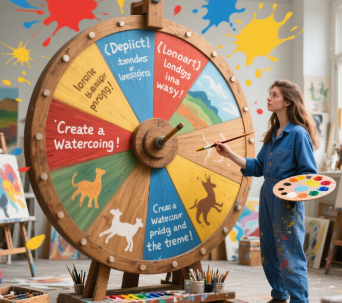In a world where creative block is a real and recurring struggle, artists—both novice and professional—are turning to innovative tools to reignite inspiration. One such rising trend is the wheel-based art prompt generator, an interactive, gamified solution designed to nudge creativity into motion. Far from being a novelty, this tool combines behavioral psychology, randomization theory, and interface gamification to offer a structured yet liberating creative experience.
How Random Prompts Drive Creativity and Combat Artist’s Block
Randomness is not chaos—it is, in fact, a proven stimulant for the creative brain. Studies in Creativity Research Journal (Finke, Ward & Smith, 1992) indicate that “structured randomness” enhances ideation by disrupting habitual thought patterns. Artists often fall into cognitive ruts—repeating color schemes, familiar themes, or overused forms. A wheel-based prompt generator, by nature of its design, introduces unpredictability in an otherwise pattern-driven process.
By spinning the wheel, artists receive a mix of prompts—emotion-based themes, color palettes, materials, subject constraints—that steer them into fresh creative terrain.

Addressing Real User Pain Points in the Art-Making Journey
After analyzing current user queries such as “how to overcome creative blocks in drawing,” “random art prompt generator online,” and “ideas for mixed media projects,” it’s clear there are three core user needs:
1. Decision Paralysis in the Creative Phase
Modern artists face a glut of choices. Whether it’s sketching concepts or choosing mediums, the paradox of choice often results in creative freeze. According to Schwartz (2004) in The Paradox of Choice, too many options can reduce satisfaction and motivation. A wheel-based generator streamlines these choices into manageable, gamified options.
2. Lack of Structured Challenge
Artists frequently seek intentional limitation to force creative growth—think Inktober or limited palette challenges. A randomized generator provides constraints without rigidity. It simulates a classroom-like assignment structure while retaining a sense of play, aligning with pedagogical best practices from visual arts education (Hetland et al., 2007).
3. Need for Instant Inspiration Across Styles
Whether creating hyperrealist portraiture or exploring surreal collage, artists need tailored sparks. By incorporating user-defined categories (like genre, technique, or emotion), the wheel transforms into a highly adaptable prompt tool. This personalization is essential, echoing findings from a 2020 Adobe Creativity Survey, where 74% of creators noted that customizable tools directly improved their workflow.
The Mechanics of a Well-Designed Art Prompt Wheel
A compelling wheel-based art prompt generator goes beyond mere randomness. It should include:
- Layered Prompt Levels: E.g., one spin for subject (“a forgotten city”), another for medium (“ink + newspaper”), and a third for tone (“nostalgic”).
- Gamified Feedback Loops: Progress trackers, reward badges, or community votes to validate and encourage user output.
- Social Sharing Integration: Allowing artists to post their creations based on spins fosters community accountability and recognition—two pillars of sustained creativity per Psychology of Aesthetics, Creativity, and the Arts (Amabile, 2018).
Platforms like spinthewheel are already tapping into this trend, offering customizable wheels that can be tailored for sketchbook starters, concept artists, and even NFT creators looking for a fresh take on digital art.
Educational and Therapeutic Applications
Art therapists and educators are increasingly integrating these tools into sessions and classrooms. The American Art Therapy Association notes that non-directive prompt generation fosters psychological safety and promotes self-expression without judgment. A randomized wheel removes interpersonal bias, offering a neutral “third party” directive that lowers resistance in therapy or critique environments.
Teachers also report improved engagement when using prompt wheels in class. According to a 2021 Edutopia feature on gamification in education, interactive choice-based tools increase participation by 43% compared to lecture-style instruction.
Why a Wheel Works Better Than a List
While traditional prompt lists (like 100 Drawing Ideas) remain popular, they are static and linear. A wheel offers kinetic interaction, adding physicality to decision-making. Research from the Human-Computer Interaction Institute at Carnegie Mellon shows that tactile engagement increases user satisfaction and information retention, particularly among visual learners.
Moreover, the spinning animation provides anticipation and dopamine-triggering reward cycles—similar to slot machine psychology—but without the addictive downsides (Dow Schüll, 2012).
Final Thoughts: Creativity at Your Fingertips
The rise of the wheel-based art prompt generator represents a shift toward playful, structured, and emotionally intelligent creativity tools. Whether you’re trying to break a creative drought, teach an art class, or find your next artistic muse, a spin of the wheel could be the nudge your imagination needs.
spinthewheel continues to develop dynamic, intuitive prompt generators tailored to artists of all levels—blending fun with functional, randomness with structure, and chaos with creative clarity.
About the Designer
Elira Voss, the lead content architect behind spinthewheel’s creative tools, is a digital interaction designer with a background in visual arts therapy and game psychology. With over a decade of experience building user-centric interfaces, she believes in transforming randomness into resonance—one spin at a time.